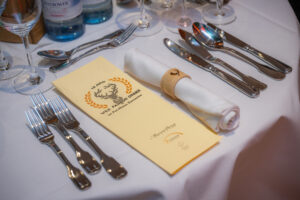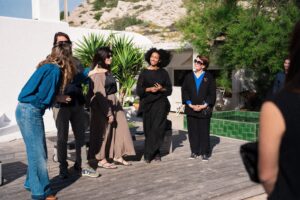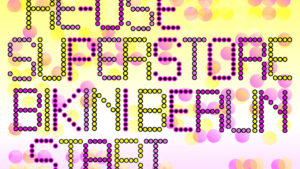Upcycling as a Creative Necessity: From Survival to Identity at Tata Christiane
Presented at “Use-less Talk” / Werkshau Exhibition, Hochschule Hannover, 16 May 2025
By Julie Bourgeois (Tata Christiane)
This talk was given as part of Use-less Talk, a series of presentations curated by Martina Glomb for the Werkshau exhibition held on 16 May 2025 at Hochschule Hannover. The event brought together designers, thinkers, and practitioners exploring sustainability, material reuse, and alternative models of creation in contemporary fashion.

Julie Bourgeois, founder and designer of Tata Christiane, was invited to share her perspective on upcycling as a creative and philosophical practice. Drawing from over 15 years of experience working with deadstock, vintage, and self-made textiles, she reflects on how upcycling is more than a technique — it is a way of resisting industrial norms, embracing imperfection, and cultivating an emotional, colorful, and craft-driven approach to design.
Titled Upcycling as a Creative Necessity: From Survival to Identity at Tata Christiane, the talk explores the evolution of upcycling from a survival strategy to a deeply personal and political ethos — revealing how limited resources can foster unlimited imagination.
Upcycling as a Creative Necessity: Creating Out of Necessity Before It Had a Name
When I began working as a designer in 2007, I didn’t call it upcycling — I didn’t even know the word. What I knew was this: I wanted to create, and the only materials I could afford were vintage clothes, fabric remnants, and secondhand textiles. Traditional supply chains, with their minimum order requirements and industrial expectations, were inaccessible.
Upcycling wasn’t a concept. It was a necessity. A way to resist being blocked by the system and to begin something on my own terms.
One early example says a lot: a shop asked me for t-shirts. Back then, this would have meant high upfront costs and potential waste. So I created something different — tops made from vintage scarves. They became my version of a t-shirt, my way to answer the market while staying true to my values. Today, I do offer t-shirts — but only made to order. No excess stock.
Upcycling as a Creative Necessity, What began from need has since evolved into:
A philosophy of zero waste
A creative playground
A method of expressing individuality
And a unique visual identity for Tata Christiane
Upcycling as a Creative Necessity Part 1: Upcycling as a Craft-Based Design Philosophy
1. Making as a Way of Thinking
Each designer has a different story. Mine is deeply linked to craft and intuition. I am self-taught, and I prefer to make rather than delegate. This proximity to the material changes everything.
When you produce yourself, you quickly become aware of waste. It’s impossible to ignore the leftovers at your feet. Early on, I began to keep every scrap. I created a system of sorting remnants, which later became the foundation for my creative patchwork — a practice of improvising new forms out of old fragments.
But beyond patchwork, I also questioned the very way I was constructing clothing. To minimize waste from the start, I designed almost exclusively with geometric shapes: squares, rectangles, triangles. It’s a method inspired partly by Japanese zero-waste design strategies and informed by my own practical limitations around Upcycling as a Creative Necessity
Later, the arrival of print-on-demand allowed me to expand sustainably. I now integrate custom-printed textiles and made-to-order basics into my collections — produced only when needed, and always in small quantities.
For those interested in exploring the broader history of zero-waste pattern making, Timo Rissanen’s work is essential reading. His book Zero Waste Fashion Design (with Holly McQuillan) explores how the practice intersects ethics, aesthetics, and sustainability.
2. Limitations as a Path to Freedom
Working by hand means limits: physical, temporal, logistical. But these limitations foster creativity. Rather than a problem, they become a framework that demands ingenuity.
I am not interested in scaling up endlessly. I am interested in depth. My dream is not mass production, but a constellation of designers, each building a unique world. I believe this diversity is the true richness of fashion.
This philosophy is also echoed in the Fashion Act Now movement, which calls for systemic transformation in fashion production and consumption — moving away from quantity and toward meaningful, regenerative creativity.
The aesthetic and spiritual significance of material transformation and form is beautifully echoed in La Vita delle forme by Emanuele Coccia and Alessandro Michele — published in French as La vie des formes: Philosophie du réenchantement. This book argues for a re-enchanted view of design — one where forms are not just functional but expressive, relational, and vital. This perspective is deeply aligned with the poetic and metamorphic logic that guides my work and Upcycling as a Creative Necessity.
Upcycling as a Creative Necessity Part 2: The Sourcing Problem (and Its Beauty)
A. Complexity and Fragility
My sourcing model blends three pillars:
- Deadstock
- Print-on-demand
- Vintage
Each comes with its challenges.
Deadstock is ideal for unique garments but not for scalable collections. I’ve faced two problems: sometimes, I couldn’t reorder fabrics when demand returned. Other times, I ordered too much, creating my own surplus. Now, instead of virtually simulating full collections, I make a virtual bargain: calculating which deadstock fabrics have the most meters available. This lets me commit to a fabric without risking overstock — balancing creativity with logistical care.
Vintage sourcing is more chaotic. I now buy most of it by the kilo. It’s a material lottery — full of surprise, complexity, and creative challenge. One example is the unique pieces collection Pilzreliq80, inspired by the regenerative nature of fungi. Here, 1980s vintage garments from West Germany were reassembled with folded fabric structures, creating volume without waste. This approach sees imperfection as prompt, not problem.
These processes require sorting, washing, creative use of flawed or unpopular items — sometimes even redistribution to other designers or reuse projects. Upcycling as a Creative Necessity is a collective mouvement.
In this approach, color becomes a core challenge and opportunity. Recycling is the opposite of monochrome — it embraces complexity, contrast, and surprise. In a world where color is vanishing from our surroundings, as discussed in this article by RTBF, upcycling is a way to reintroduce fantasy, emotional resonance, and visual diversity into our daily lives. It is an act of aesthetic recovery, a declaration of vibrancy against a backdrop of uniformity. For deeper insight into how I use color at Tata Christiane, see How to Combine Colour with Tata Christiane and A Maximalist Love Affair.
Upcycling as a Creative Necessity Part 3: The Realism of Upcycling
A. The Hidden Complexity of Materials
Working with vintage means dealing with the unknown:
- Fiber content may be uncertain
- Washing instructions often missing
- Fabric impurities or fading can create risk
For labeling and exports, this is complicated. I spend significant time managing declarations and adapting to customs regulations.
The Centre for Sustainable Fashion offers excellent guidance on how small brands can navigate these challenges while remaining rooted in ethical principles. Additional insights and resources tailored to the German context can be found in Insights and Tools for Independent Designers in Germany.

B. Cataloging and Classification
Each unique piece needs:
- A reference code
- Photographs
- A full listing
This can be overwhelming. Technology helps: I use AI tools for background removal in photography and to draft descriptions. But the labor remains intense.
I’m also developing a better system of tracking items across platforms and organizing fabric origin documentation for customs.
C. A Hybrid Sales Model
I sell through:
- Made-to-order seasonal collections
- Consignment partnerships
- Online shop
- Collaborative designer stores

Consignment partnerships offer freedom and long-term relationships. My experience with Japan — particularly with Wut Berlin and Destination Tokyo — shows how certain cultures embrace upcycling, uniqueness, and emotional value in fashion. Japanese audiences, with their appreciation for care, detail, and imperfection, have been deeply receptive.
Collaborative designer stores like RARE Berlin offer a radically different model. Co-founded with Therapy Recycle & Exorcise, Everyday Pieces, and Fade Out Label, RARE is a Berlin-based community store now listed in Billie Eilish’s sustainable fashion guide. RARE promotes upcycling, community, DIY spirit, and expressive, conscious fashion. With rentals, upcycled pieces, and direct customer contact, it’s more than a shop — it’s a fashion ecosystem.
Reuse Superstore is another important platform — an initiative supported by the Berlin Senate. Focused on community reuse and circular fashion, Reuse offers space, support, and retail opportunities to sustainable fashion makers. It’s a state-funded initiative that bridges sustainability with local engagement and policy-level support. Learn more at re-use-superstore.de
Upcycling as a Creative Necessity: Upcycling as Resistance, Ritual, and Renewal
Upcycling is more than a method. It is resistance.
Against fast fashion. Against waste. Against repetition. It’s a commitment to care, time, and narrative.
Each Tata Christiane piece carries:
- Memory
- Craft
- An emotional and ecological logic
In a world overwhelmed by speed and sameness, this is my way of saying: slow down. Look closer. Begin again.
For further reading, I highly recommend Kate Fletcher’s foundational work, Craft of Use (available here), which explores how we value, use, and relate to clothing beyond consumption.
Upcycling as a Creative Necessity is survival — but it is also a poetry of persistence.
Thank you.





























